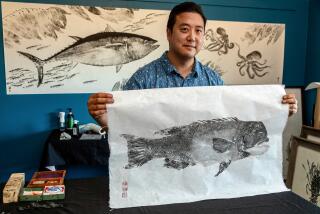Corona del Mar Artist Is Egged On by the Desire to Create Different Tableaux
- Share via
For fun, artist Philip Kulik paints illusions, such as the large cardboard box that looks like a fireplace and stands next to a real one in the living room. “I do it to fool the eye,” he said.
His more serious artwork is done on ostrich eggs to please the eye.
“In my past, I probably could have made more money painting T-shirts,” said the Corona del Mar artist, who operated antique and florist businesses before settling on painting designs and scenes on ostrich eggs for his artistic outlet.
“It is unique, and it is my own thing,” he said.
Kulik, 42, is a self-taught artist and has never had a lesson or attended an art school. “I’m not a student of any artist or school, and I don’t agree with academic artists who are taught to take this and do that with this.”
He contends that it is the final result that counts. “It makes no difference how you achieve it,” he said during an interview in his apartment studio, where he was painting a design on one of his ostrich eggs.
“Sometimes I paint over the same part 18 times until I think it stands out,” he said, explaining that it usually takes 70 hours to complete an egg.
“I’m taking all of my life’s experiences and putting them on eggs,” he said.
Painted ostrich eggs sell for $1,000 and more, and his jeweled creations--some with diamonds and rubies--fetch upward of $5,000. Most are bought by collectors, although he said a sheik once bought five of them for his wives.
He buys ostrich eggs from importers for $35 each.
“I try to keep the price of the finished, painted egg about $1,000, but when I start adding jewels, it starts adding up, just like buying a car,” he said. “If you buy the stripped model, it costs less.”
Since starting his egg-painting career two years ago, Kulik has completed about 100 eggs, sometimes working throughout the night and early morning. “Once I get into it, I can’t stop.”
Most are of his own design, and he often uses his colorful, home-grown flowers as models for scenes on the eggs. “You can’t get the same depth when you copy it from a picture,” he said.
Despite the tedious work, Kulik said he gets more joy from painting the eggs than from painting canvasses.
“I got bored doing the same thing over and over again, but with the eggs, there is no end to what can be done,” he said.
Kulik’s twin brother, Paul, is his broker. “He has to sell them. All I have to do is make them,” he said.
Bryan Reese, 28, got the railroading bug while working as an engineer at Knott’s Berry Farm, so two years ago he bought an old Southern Pacific dining car that he fixed up and rented to groups for parties. The car would hitch a ride on Amtrak, and he would be the host.
But Reese now has his car up for sale. “Amtrak won’t let me hook up on the San Diego run (anymore), and most trains out of Los Angeles are running to capacity and won’t take me. I think we’re seeing the swan song of private railroad cars. “
The Orange resident said he doesn’t want to get completely out of railroading, so he plans to make train videos.
“There’s a big market for these videos,” said Reese, who has a degree in film production from Cal State Fullerton.
The price tag for his car is $115,000, “and if I get that price, it will allow me to think nice thoughts of private railroading.”
Toys being made at Pacific Seacraft in Fullerton for the Orangewood Home for Abused Children are not fashioned from ordinary wood.
The little sailboats, wooden horses and wagons that will be pieced together Saturday by 80 volunteer employees at the sailboat-building company will be made from teak, the same wood used to build full-size sailing ships.
“We use the scraps to make the toys,” said company spokeswoman Cindy Garcia of Mission Viejo.
